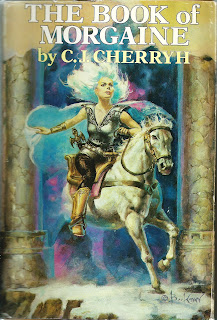Happy Day !, by Geoff Ryman, is a novelette that appeared for the first time in this anthology. It's set in a near-future USA, where women have taken control, and macho men are systematically being exterminated, since, as one observer remarks, 'men are violent'. The 'Boys' are a detachment of gay men who agree to assist with the extermination process, in exchange for being allowed to live.
Rich, the first-person narrator, decides to extend fellowship in the Boys to an alienated wanderer named Royce; this has consequences for the future of the group. This novelette tries very hard to be transgressive, calling to mind Harlan Ellison stories from the 1970s and 1980s. The homosexual cohort described in 'Happy Day' are not pleasant people, and their portrayal likely would be considered politically incorrect (even offensive) by modern standards.
The Cabinet of Edgar Allan Poe, by Angela Carter: a 'fabulation' that deals with the relationship between the writer and his mother, amid the poverty, disease, and premature death commonplace in 19th century America. It's fully as dreary as it sounds.
The Flash! Kid, by Scott Bradfield: a snotnosed delinquent named Rudy McDermott discovers something alien and unknowable inside a termite nest, and the World is never the same. This story tries to emulate the comedic sci-fi of Robert Sheckley and Ron Goulart, and if you like that kind of stuff, then you might like 'The Flash! Kid'. I didn't.
After-Images, by Malcolm Edwards: when World War Three arrives, by some freakish phenomenon of physics, a small English town survives immolation. Or has it ? A great story, and one of my 'Top 21' horror stories. Unfortunately author Edwards, a playwright, did not produce any more short fiction in his career, preferring instead to work as an editor and critic.
Kitemaster, by Keith Roberts: in a vaguely post-apocalyptic UK, soldiers of the Church keep watch for incursions of 'demons' from the Badlands. This story later would be part of Roberts' 1985 fix-up novel 'Kiteworld'.
The Monroe Doctrine, by Neil Ferguson: it's an alternate 1968, and when the Russians invade Czechoslovakia, U.S. President Marilyn Monroe decides to meet face-to-face with Soviet Premier Leonid Brezhnev to advance the cause of World Peace. This story tries so hard to be cute n' sassy. It was author Ferguson's first published story.
Angel Baby, by Rachel Pollack: a teenaged girl is molested by an angel.....?! A provocative premise, but the story fails to capitalize on it. Most of 'Angel Baby' is devoted to documenting, via lengthy internal monologues, the angst of our stricken teen.
On the Deck of the Flying Bomb, by David Redd: the protagonist is a crewmember on the Mother of all Cruise Missiles. He is unhappy about the one-way nature of its mission. This is a figuration that is more of a fragment than a completed short story.
Cyberpunk maestro John Shirley provides 'What Cindy Saw', a variation on the theme of 'is someone crazy, or just gifted with the ability to see the underlying reality of the world' ? An early entry from Shirley, this story has a kind of crazed energy that makes it readable, if a little contrived.
The Object of the Attack, by J. G. Ballard: Dr. Richard Greville, psychiatrist, has a patient with severe antisocial tendencies. But perhaps that is a good thing ? One of Ballard's more accessible short stories, although its premise owes something to Stephen King's 1979 novel The Dead Zone.
Something Coming Through, by Cherry Wilder: in a near-future Arab city known as Deskar, Wheeler, an American, tries to save his relatives from execution for the crime of possessing alcohol (Deskar has a quasi-Muslim sensibility). Can a local herb salve his misery ?
Dreamers, by Kim Newman: in the future, you can live vicariously by downloading and experiencing other people's dreams. John Yeovil has gotten rich off of specializing in porno dreams, and a new dream, featuring JFK and Marilyn Monroe, could make him very wealthy indeed.........this story has some interesting proto-cyberpunk concepts, but its overly wordy, and poorly organized, narrative ultimately fails to impress.
Tissue Ablation and Variant Regeneration: A Case Report, by Michael Blumlein: in the future, body parts can be used to improve the lives of impoverished Third World Peoples. But there's a catch............this story is disturbing and treads into splatterpunk territory (author Blumlein's 1990 anthology of horror stories,
The Brains of Rats, got
a rave review from the Too Much Horror Fiction blog).















































































